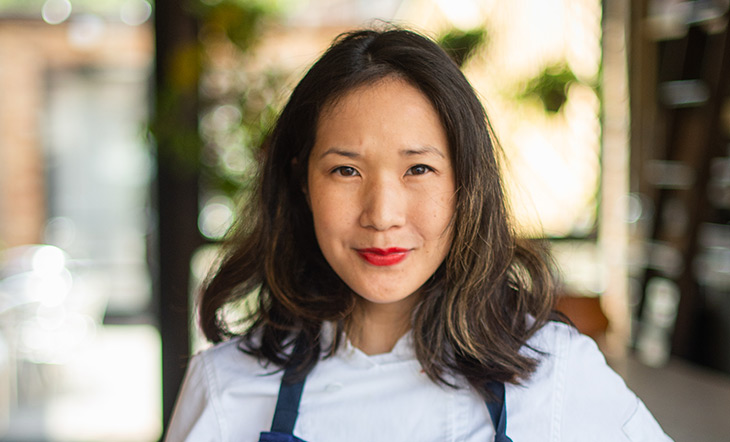How to Make Motherhood Sustainable in the Culinary Industry
Chefs and owners are rethinking how childcare fits into a successful career
Layla Khoury-HanoldMarch 29, 2021

Our industry is in crisis. The COVID-19 pandemic has already permanently shuttered 17 percent of restaurants nationwide, forced millions into unemployment, and left chefs, owners, and workers struggling to imagine what the future looks like in the near- and long-term. As states move from re-opening to returning to restrictions on dining and the industry continues to try to adapt, we're sharing stories from the front lines of businesses reacting to this new landscape. Below, Layla Khoury-Hanold dives into the struggle for working mothers in the hospitality industry—prior to, during, and post-pandemic—and how women chefs and owners are striving to create an industry where having a child is not an impediment to success.
--
Chicago chef Becca Grothe works full time at Honey Butter Fried Chicken and runs TriBecca’s, her sandwich delivery business, while juggling motherhood and household responsibilities.
“Chores get pushed to [my day off],” Grothe says. “Now I’ve gotta vacuum and get everything ready for the whole week. When I come home at 9:00 P.M. [after work], I’m not in the right headspace to pay bills.”
Balancing motherhood with a career is a familiar tale. The lack of standardized parental leave and childcare, combined with systemic issues such as pay disparity and workplace discrimination, have long threatened working mothers’ capacity to sustain a career. But even within this broader labor landscape, the hospitality industry has proven uniquely challenging for working mothers. Industry-wide, women leaders are taking on the issues that are key to cultivating sustainable culinary careers, from childcare and culture to work-life integration and mentorship.

The pandemic has only exacerbated the rate at which women are leaving the workforce to be primary caregivers. Women started 2020 roughly equal to men, holding 50.03 percent of jobs. But by year’s end, they held 860,000 fewer jobs than men—a gap underscored by sharp losses in hospitality. This decline has adversely impacted Latina women, who have the highest unemployment rate at 9.1 percent followed by Black women, at 8.4 percent.1
Grothe considers herself lucky. When her son was born in 2018, she was working full-time at Sunday Dinner Club, sister restaurant to Honey Butter Fried Chicken, where her husband also works. They each received three months of paid parental leave. When the couple resumed work, they staggered schedules to share caregiving duties. Last summer, despite pandemic-related concerns, their toddler started daycare part-time. “Our son needed to be in daycare as much as we needed him to be in daycare,” Grothe says. “It’s more of a financial strain but I can see a difference in my son’s [development].”

Not everyone is able to make those choices. When Beverly Kim, the James Beard Award–winning chef/owner of Chicago’s Parachute and Wherewithall, was starting out, women were stereotyped as “too soft to work the line.” Even if a woman climbs the ranks, the timing of competing for executive chef positions often coincides with her childbearing years. Culinary jobs demand physicality and long hours—without paid parental leave to facilitate recovery time for mothers, it’s difficult returning to intense line-cook or service shifts. There’s also the question of finding childcare.
Kim spent most of her wages on private childcare. To support her family while opening Parachute, she relied on Medicaid to access subsidized childcare with night-care hours. “When you hit motherhood, it’s hard to stay in the game,” Kim says. “I see a lot of women in my own business self-select out—they just want to have a family.”
Access to affordable, reliable childcare is a universal issue for working mothers, but the lack of night-care hours especially impacts hospitality workers who rely on high-earning weekend and night shifts. Securing private childcare is often financially prohibitive: food service workers’ weekly wages average $4422 while weekly childcare costs average $565 for a nanny3.
Some businesses offer stipends. Last year, when Shauntrice Martin founded The Black Market, a Black-owned grocery store in Louisville’s West End, she addressed employee-sourced requests for childcare assistance by covering expenses for the first month of employment, followed by a monthly stipend.

But stipends are a band-aid, with potential liability. To offer her employees accredited, subsidized childcare, Camilla Marcus, who owned west~bourne in New York City for two years, partnered with Vivvi, a start-up open to accommodating night-care hours. Unfortunately, the nascent partnership was upended by COVID-19. “There has to be enhanced incentives or regulations for having providers that have to provide for this entire industry,” Marcus says. “Our people deserve better. Why should the [second] largest private employer be relegated to these informal networks?”
When Farah Masani, a farmer and Barcelona Wine Bar’s head of purchasing, visited her native India, she saw how the economy rallied around its call center workers, providing evening-hours access to childcare and schools. “Working the night shift in an American factory or working night shifts in restaurants is not new,” Masani says. “Why haven’t we, as an economy, created any service[s] to fulfill [the needs of] these workers?”
-(1)-opt.jpg)
To create a broader societal shift, we need government support for standardized parental leave and subsidized childcare. Cultural change within the hospitality industry is possible, but restaurants must become financially sustainable to back things like childcare, health insurance, and better wages. “We need to be advocating for other revenue streams besides, ‘How many people can I cram in at 7:00 P.M. on a Saturday?’” says Sarah Stegner, the James Beard Award–winning chef/owner of Prairie Grass Cafe. “I need to raise revenue and have enough profitability so we can [fund] these things.”
_West-bourne_Credit-Bogdana-Ferguson-opt.jpg)
The pandemic has forced owners to incorporate new distribution channels; Stegner now sells soups and sauces to onling grocery service Fresh Midwest. Emergency meal relief programs, like those benefitting frontline workers, have also emerged as a secondary revenue stream. These streams also provide flexible employment hours, a boon to working mothers with limited availability for traditional restaurant shifts.

Last year, Kim and her mentor Stegner co-founded The Abundance Setting, a nonprofit that “supports the advancement of working mothers in the culinary and hospitality industries to have a sustainable career while maintaining a quality life at home.” They started with a three-month meal relief program, now in its second round, that pairs mentor chefs with working-mother chefs in Chicago to provide three meals weekly, rotating pairings monthly. Receiving meals alleviates some financial burden and facilitates family time, while weekly calls cultivate the mentorship that fostered Kim and Stegner’s own successes.
“It gives me more ideas [for] when I open my own place,” says Grothe, one of the initial recipients. “It’s a great feeling knowing that these women—who have children and are still successful, who own their own places, who are executive chefs—are in my corner and want me to succeed.”
Learn more about the James Beard Foundation's campaign to keep restaurants open for good.
--
Layla Khoury-Hanold is a freelance journalist whose work has appeared on Food Network, Saveur, and Refinery29, and in the Chicago Tribune. Follow her on Instagram @words_with_layla or on Twitter @words_withlayla.
1. Data cited from Bureau of Labor Statistics’ collated in CNN article "The US economy lost 140,000 jobs in December. All of them were held by women."
Overall, women are still down 5.4 million jobs from February, before the pandemic began, as compared to 4.4 million job losses for men. They started 2020 on roughly equal footing, with women holding 50.03% of jobs, but ended it holding 860,000 fewer jobs than their male peers.
That gap is in large part due to steep job losses in three sectors: education — which remains a female-dominated industry — hospitality and retail, particularly clothing and accessories stores. All of these industries have been hammered by the pandemic.
Among women, Latinas currently have the highest unemployment rate at 9.1 percent, followed by Black women at 8.4 percent. White women have the lowest unemployment rate at 5.7 percent.
2. According to the U.S. Bureau of Labor Statistics’ Food and Beverage Servers Occupational Outlook Handbook, the median hourly wage for food and beverage serving and related workers was $11.06 in May 2019.
3. According to Care.com data published in the article “Child care costs more in 2020, and the pandemic has parents scrambling for solutions,” weekly childcare costs have risen significantly over the past six years. The average weekly childcare cost for one infant child is $565 for a nanny, $215 for a day care center (also referred as a "childcare center") and $201 for a family care center.






